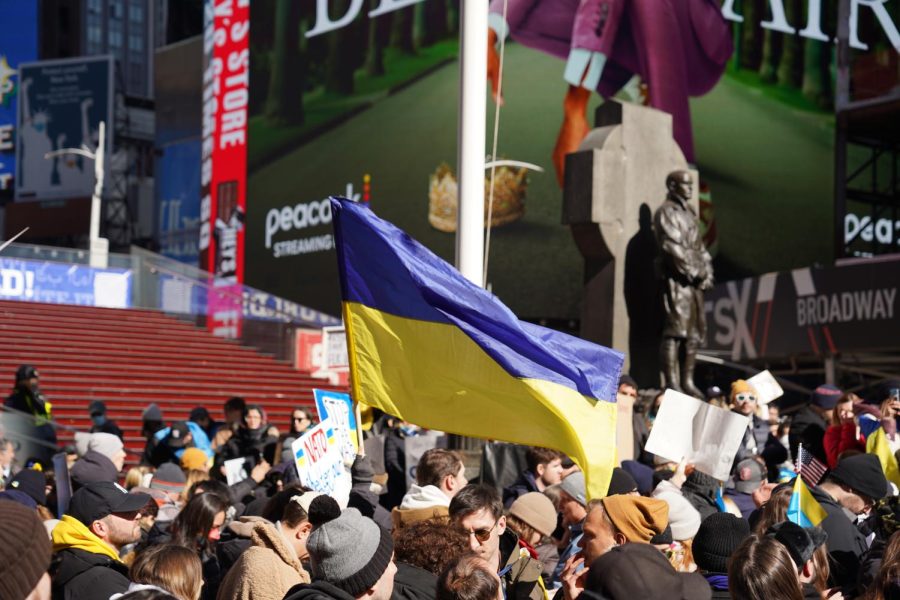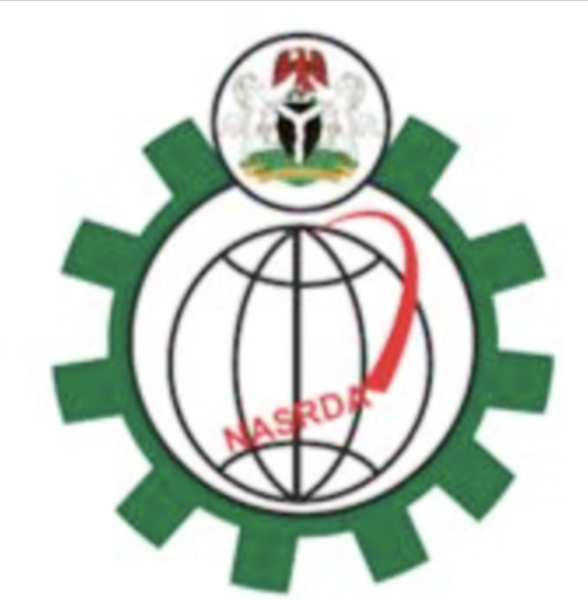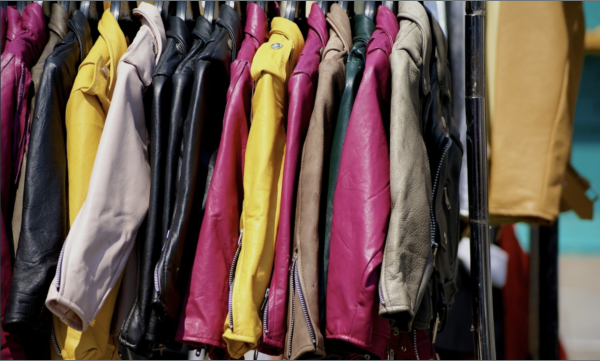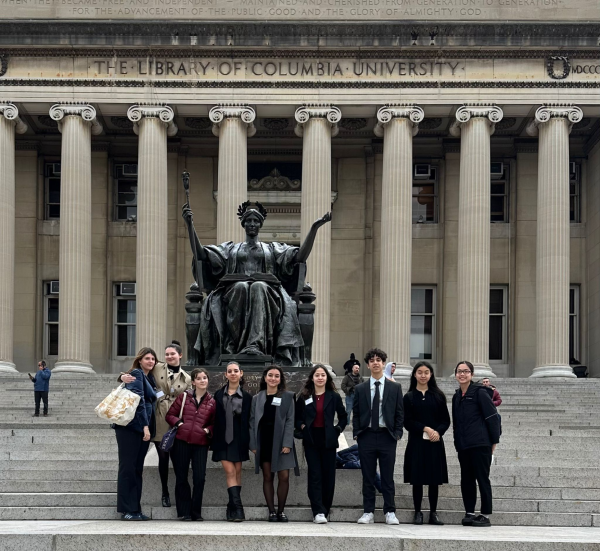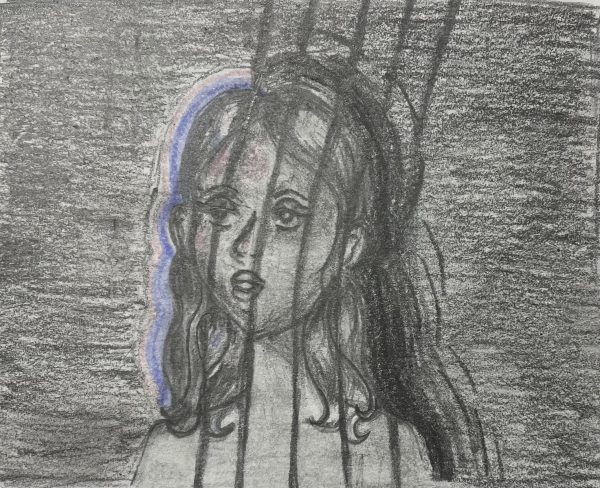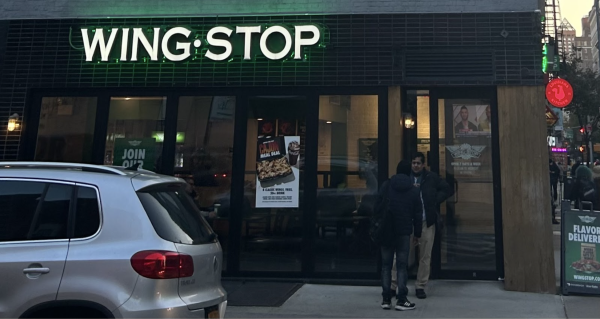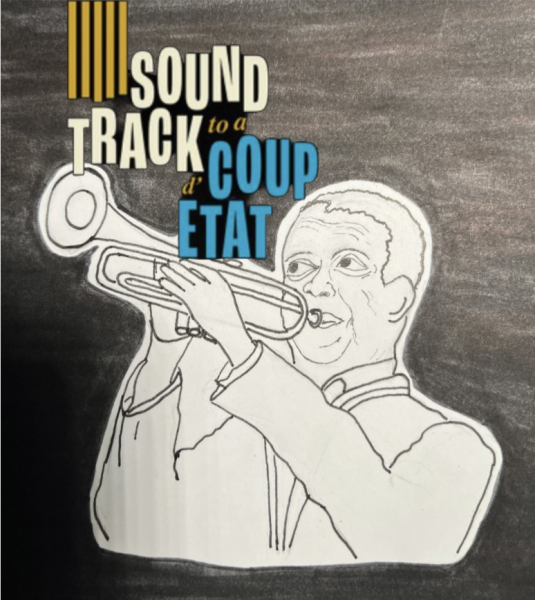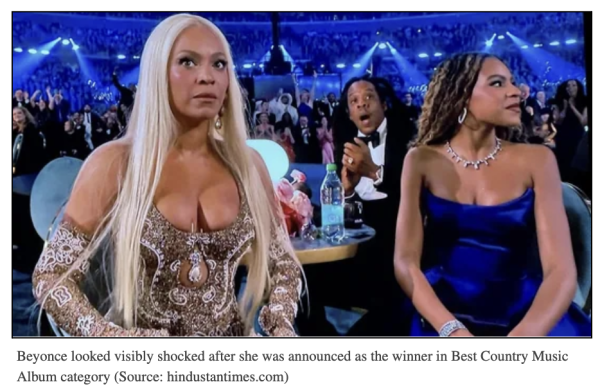A Primer on the Russia-Ukraine War
Photo by Ethan Li
Protest on Times Square, February 26, 2022
No one enjoys being forcefully woken up.
The Ukrainians did not either, when explosions and airstrikes drowned their cities the hour before the clock struck six on Thursday, February 24.
If you’ve read the news recently, you’ve probably seen a variety of intense headlines on the recent invasion of Ukraine by Russia, escalating to stark predictions of an incoming World War III. But the current situation in Ukraine is much more complicated than a simple foreboding headline. What might seem like a scary and sudden situation is actually just the climax of decades-long tension between Russia and Ukraine, and there are multiple factors spurring the latest updates. In this primer, we’ll help explain what exactly is occurring in Europe, what this means for the world, and share our predictions for the conflict.
First, we feel it’s necessary to take a short dive into the complicated history of tension between Russia and its neighbor, Ukraine. Why is Russia so interested in Ukraine, and what is Ukraine’s role in this developing great power rivalry? Ukrainian unity is a complex idea that dates back centuries, but for this primer, we’ll focus on the 20th century. The concept of a Ukrainian state was first introduced following the 1917-1922 Ukrainian War of Independence, a series of conflicts resulting in the establishment of a Ukrainian republic. However, in 1922, Ukraine was fully absorbed into the Soviet Union following the Russian Communist Revolution which concluded in 1923. Under the dictatorship of Joseph Stalin, Ukraine faced many struggles throughout the century, including the 1932 Holodomor, or Great Famine, widely believed to have been orchestrated by Stalin resulting in the deaths of millions of Ukrainians. This led to a Russian diaspora in Ukraine in which large numbers of Russians were sent to repopulate and rebuild the depleted eastern region.
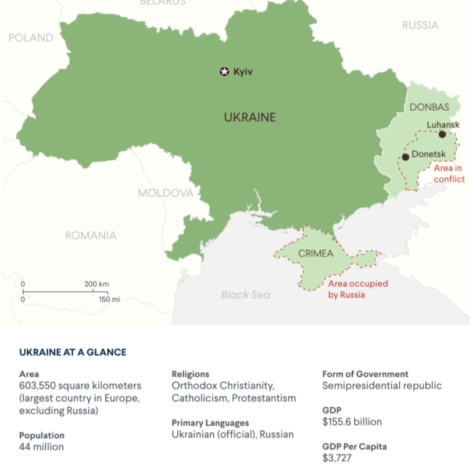
This disastrously affected the ethnic makeup of Ukraine when it became independent in 1991 following the breakup of the Soviet Union. As a member of the Soviet Union, Ukraine was valued highly for its agricultural production, defense industries, and military, thus its decision to leave deeply impacted an already struggling Russia. Despite this independence, Ukraine became strongly polarized, as eastern Ukraine continued to lean on Russian leaders due to its largely Russian population and western Ukraine developed closer ties with European powers, thus leaning towards Western political entities such as the European Union and the North Atlantic Treaty Organization (NATO). This tendency to prefer the West was highlighted in the 2004 Orange Revolution, a series of peaceful protests defending the election of the Ukrainian government from Pro-Russian President Victor Yanukovych’s attempts to “steal” the presidency. These protests were significant as they drew the line between an increasingly democratic Ukraine population and increasing authoritarianism in Russia, highlighting Ukraine’s newfound national unity. Furthermore, the 2013-2014 Euromaidan protests in Kyiv and subsequent ousting of Yanukovych pushed Ukraine even closer to the West, as they resulted in European diplomats interference in the situation, convincing Yanukovych to sign an association agreement with the EU and establishing a free trade agreement between Ukraine and the EU. These two events deepened the rift between Ukraine’s East and West, spurring conflict between Russia and Western political organizations and largely influencing what some see as the trigger to the current crisis: the 2014 Russian annexation of Crimea.
Following the results of Euromaidan, Russia quickly began moving Russian soldiers who would be known as “little green men” into Crimea, which was a part of Ukraine at the time. Crimea is a region dominated by ethnic Russians; it was originally territory of the Russian Soviet Socialist Republic, but the USSR leader Krushchev gifted it to Ukraine in the 1950s. This was not an issue at first as Ukraine and Russia were still parts of the USSR, but the dissolution of the USSR paired with Ukrainian independence formalized Crimea’s separation from Russia. This incited internal disagreement in Crimea over its nationality as well as Russia’s unacceptance of the peninsula as truly Ukrainian, regardless of the post-independence treaty that promised Russian respect for Ukrainian borders. In 2014, the Kremlin ran an ‘illegal’ referendum in Crimea and used the results of this event as justification for the annexation of the region later that year. The Russian government also backed separatists in the Donbas region, promoting instability in Ukraine and setting the foundation for the current crisis.
These actions were viewed as retaliation to NATO’s historical opposition to Russia and its communist predecessor, and more significantly, as a response to NATO’s announcement of an initiative to expand its membership to Georgia and Ukraine—a clear threat to Putin’s sphere of influence in Eastern Europe. Ukraine and Georgia gaining membership would allow NATO to place military bases within their territories, placing NATO right on Russia’s border and decreasing its sense of security as well as its influence. However, it must be noted that NATO was in Russia’s backyard long before it opened up to Ukraine and Georgia; before this initiative was introduced, the alliance had already secured the membership of other former Soviet satellite states such as Poland, the Baltics, Hungary, and Romania. NATO enlargement threatened Russia for decades before its government retaliated in 2014, and these decades were filled with empty promises from NATO promising to stall its expansion to the east. Its neglect of the follow-through of these promises furthered anti-Western sentiment in Russia, encouraged Putin’s aggressive move on Crimea, and motivated Russia to back the separatists in Donbass in order to destabilize Ukraine.
To understand how exactly the crisis jumped from geopolitical posturing to what is the first large-scale interstate European war since World War II, one needs to understand the Donbas crisis and the Russo-West dynamic in the past month. The Donbas region, found in the east of Ukraine consists of two parts, the Luhansk and the Donetsk. This region, similar to Crimea, consists of a large population of ethnic Russians, many of which are pro-Russian separatists. In April 2014, these separatists, alongside Russian forces, declared the independence of the People’s Republic of Luhansk and Donetsk, taking over territories and sparking a full-scale war between them and the Ukrainian government. All diplomatic attempts to resolve the situation have failed. According to Aljazeera and UNHCR, the civil war has claimed more than 14,000 lives and displaced a staggering 1.5 million. The conflict in this region also allowed Russia to increase its involvement in that area by sending in troops and weapons to back the separatists.
The Kremlin’s recent response to the Donbas crisis foreshadowed the shift in Russian foreign policy. If Russia had chosen not to support separatism and instead promoted increased autonomy of the region under the Minsk Accords, it would have political influence with none of the consequences of global condemnation. However, Putin chose instead to back separatism, recognize the People’s Republic of Luhansk and Donetsk, and declare a historical claim over Ukraine by stating that Ukraine was “entirely created” by “Bolshevik, Communist Russia”. This signaled a shift in Putin’s priorities from a strategically optimized approach to one that prioritizes historical claims; political analyst Tatiana Stanovaya summarized this change as “less pragmatic, and more emotional” in an interview with The New York Times, highlighting the erratic and somewhat unpredictable nature of Putin’s new stance.
At the end of the day, this change in the Kremlin’s foreign policy approach is just another force pulling the strings of diplomacy between the two sides taut, and it is but one consequence of the real issue: NATO expansion. It cannot be ignored that NATO introduced the initiative to expand without any real necessity or huge demand for it by members, pinpointing it as the initial aggressor driven by liberal values. While the violence and war-promoting steps taken by Russia are still not justified by blaming NATO, the alliance’s role in instigating the conflict cannot be ignored. NATO’s actions did not only incite Russian retaliation but also provided Putin a guise and excuse to take more dramatic actions such as placing troops on the Russo-Ukrainian border. In the peace talks preceding the invasion of Ukraine, a key point of debate and a key Russian demand was the complete halt of NATO’s expansion to the east. While this demand was rejected by the US and its allies, NATO’s declaration that it did not plan to let Ukraine join more or less carried the same implications. The choice to verbally turn down Russia’s demand while fulfilling it indirectly highlights the political posturing that not only strained diplomacy with Russia but also indicated that the West would not take a stance of drastic opposition— a prediction that was unfortunately proven true in the face of the invasion.
Citing NATO’s continued expansion to states on its border as a threat, the Russian government began placing more than 100,000 troops on their border to Ukraine in December of 2021. This was the first warning sign of a potential war, but even then, it was hard to discern if war was Putin’s real goal or if the troops were just meant as a threat or a means of coercive diplomacy. However, Russian military experts warned ahead of time that the tanks were ‘fully dressed’ and that the placing of missiles was not one that implied peace. Furthermore, British Armed Forces Minister James Heappey noted that Russia was building military field hospitals and bridges, whose permanence in comparison to mobile troops and tanks was perceived by many analysts as the first sign of war. There was a point in early February where Putin claimed that troops were retreating, but this was disproven quickly by satellite images. This was followed by another statement from the Russian president in which there was a promise to send Russian peacekeepers— in other words, military force— into separatists states in the Donbass region. For the Ukrainians, this was just another manifestation of the threat of invasion they had lived with for the last eight years. For the world, it was the crux of a crisis that would either undermine or assert the international order.
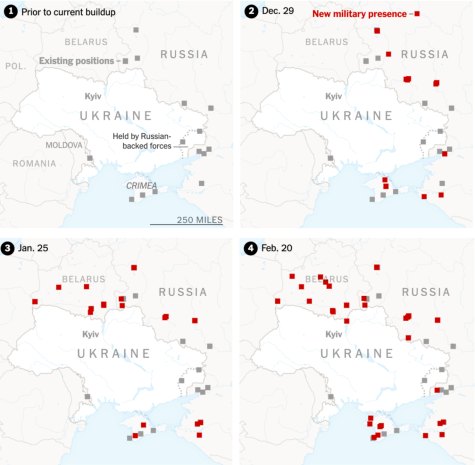
At the crack of dawn on February 24, 2022, before the clock struck 6:00 AM, a cacophony of airstrikes and bombs were launched into Ukraine’s biggest cities in tandem with President Vladimir Putin’s speech declaring a “special military operation” in Ukraine aimed towards its demilitarization and using images of explosions and cadavers as a pretext for the invasion. Putin also argued that Russia’s operation was meant for Ukraine’s ‘denazification’, citing the increasing influence of extreme neo-nazi groups in Ukraine such as the Azov battalion— which gained more influence when the government made it a part of the National Guard— as one of the priorities of Russia’s military intervetion. These reasons would be factual in the best case scenario, but even then they would not cancel out or justify the reality that Russia still breached international law and invaded another country.
The fact that the best-case scenario of these times would be the worst-case scenario a few months ago speaks volumes on the downfall and demise of peace and stability in current affairs. But even this hypothetical best-case scenario is unlikely to be true, as international experts such as Ian Bremmer and Stephen Wertheim have noted. The invasion wrecked devastation on cities full of civilians, not military bases, rebutting the argument that this violence is aimed towards demilitarization. Kyiv and Kharkiv, Ukraine’s largest cities, are the current targets, and their civilians have resorted to using the local metro as bomb shelter. Furthermore, US satellite and intelligence has revealed that the images presented by Russia as an excuse are actually false flags. The excuse of denazification is a weak one too; while there is a very real threat of a rise in right-wing extremism and neo-nazism in Ukraine, Putin has exacerbated this threat and is using it as propaganda. The Russian president does not actually care for the future of the Jews, as can be seen by Russia’s choice to attack the two out of four cities with the majority of Ukraine’s Jewish population, displacing them and destroying the majority of their possessions in the process. In addition, the president of Ukraine himself is a Jew descended from a family partially wiped out by Nazis, so the choice to make Zelensky and his family a target does not align with Putin’s claims.
The actions of Russia have angered and worried all nations, Western leaders such as U.S. President Joe Biden, and other members of the G7. NATO had an emergency meeting last Friday, where it resolved to send more troops to its members in Poland and other Baltic states. Ukrainians have found themselves reduced to collateral damage, crowding metro stations and frantically trying to escape the war in long lines of traffic towards the west. President Zelensky has declared martial law, banned any Ukrainian male between the ages of 18 and 60 from leaving the country, and distributed weapons to citizens. Belarus faces heavier sanctions for its complacency with Russia and for allowing troops to move in from its direction. Protests have broken out everywhere from New York to Moscow against war, and paranoia and fear of an incoming World War III has gripped many ordinary people. Even professional political analysts that have studied Putin for years find themselves scrambling to explain this drastic aggression.
The contagious paranoia of global war is not without merit, but the actual probability of global war at the moment is very low. Despite increased tensions between the West and Russia since 2014, today’s world is too interconnected— economically and politically— to handle a global war. Russia’s largest trading partner is the European Union and resource shortages in Europe threaten the US economy. A global war on the same scale as past world wars would be disastrous on an unprecedented scale for everyone, not just the main political actors. The very reason both NATO and Russia want to avoid Ukraine’s membership in the alliance is because it would invoke Article 5 of collective defense citing the invasion and automatically start a global war. In light of this, the US and NATO have explicitly stated that they will not deploy troops to Ukraine, diminishing the likelihood of a Third World War. In addition, China, a crucial ally to Russia, has approved its wheat imports to lessen the impact of sanctions, but it drew the line at backing Russia’s war and abstained from voting in the Security Council on the issue.
Even Putin has no interest in global war; despite the erratic and historical claim-centric aggression of the president, his actions were encouraged by the assurance that there would be no military intervention by NATO or the US. This hesitation from the West is not solely due to the fear of global war, although the implication of sending Western troops— which would officiate international war— is a strong motivator for inaction. The US and its allies also fear economic consequences for themselves; in an age of interdependence, heavy sanctions on Russia would also impact other nations such as Egypt, Libya, and Lebanon, who import much of their wheat from Russia. The result? An overall ‘weak’ response from the West that only provides supplies and imposes limited sanctions. Even the attempt to condemn Russia by the UN was vetoed by Russia’s ambassador, who was —ironically, might we add— the chair of the discussion on Russia’s aggression. However, the impact of this nonmilitary aid must not be completely ignored either. The sanctions by the west have caused much economic damage to Russia, and the worth of the ruble in relation to the US dollar dropped by 30% by February 28. The military aid from the US and the EU combined amounts to $852 million dollars worth of weapons, and even Germany is providing 1000 anti-tank weapons and 500 Stinger surface-to-air missiles in an unprecedented shift from its usual policy of banning weapon exports to conflict zones.
Since the invasion, multiple actions aimed at Russia have been taken, such as personal sanctions imposed by the EU and the UK on Putin and the deployment of 5000 NATO troops to the Baltic states and Poland. President Biden has also met with his G7 counterparts to discuss further consequences on Russia, calling the event an “unprovoked and unjustified attack” targeting global peace and security. The most aggressive action was taken on February 26, when the US and EU sanctioned Russia through harsh limitations on the SWIFT banking system that led to a decrease in the ruble’s worth and inflation in Russia. Other sanctions include those on President Vladimir Putin and his foreign minister, which target their personal assets. NATO also hinted at serious consequences for Belarus in a speech made on Friday, asserting that its aid to Russia will not go unpunished. It is evident that Western actors do not plan to leave Ukraine unprotected in this fight and further actions will be taken to delay Russia’s military aggression, regardless of the actual success rate of these actions.
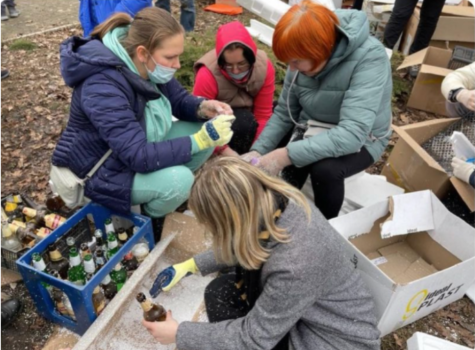
In the meantime, though, Ukrainians will have to fend for themselves. In Dnipro, women took to the streets to spend the day making Molotov cocktails in anticipation of a Russian attack. As many as 4 million are predicted to be displaced. Many homes have already been subject to destruction from shelling, and when the post-war era arrives, many will find their old houses, neighborhoods, and towns disfigured beyond recognition. Many will not get to see them again, having instead become another casualty for politicians to cite while they point fingers at each other. It is a grim reality that Ukrainians have been trying to cope with; some by fleeing to what they hope is a safe haven for them and their family, and others by choosing to remain in an act of defiance. Because regardless of whether there will be a global war or not, Ukraine will suffer and lose plenty before any conclusion, and the suffering of its people has already begun.
It would be imprudent to conclude any primer without stating predictions for the million-dollar question of “what next?” but a confident answer is becoming less and less likely as days pass. A week ago, our prediction would have gone along the lines of disbelief at the thought of a Russian invasion, and yet time has proven us wrong. The change in Putin’s mindset in terms of foreign policy is too new for completely accurate predictions but there are some aspects that have not changed in the whole crisis and war. The West’s hesitant approach is one, and we predict the military inaction from NATO will continue, even as more economic sanctions are imposed. There is also a high possibility of talks being started up again at some point, even if the Biden administration currently has no plans for any negotiation. Russia will most likely continue its relentless expansion into Ukraine, and Putin is also expected to crack down on protesters even more than he already has . The attention on Eastern Europe at the moment is also an potential distraction for other state actors such as China to advance their interests such as Hong Kong or Taiwan, although it could also be argued that the international community’s newfound wariness of aggressors could actually hone their focus on China’s actions in that region.
The conclusion of the war will also have heavy implications for other similar cases across the globe such as the Israeli-Palestine conflict, and China’s historical claim to the South China Sea. This impact is not restricted to solely current events either; many have noted and critiqued the similarities between Russia’s current actions and the US’s campaign in the Middle East —the 2003 Iraq War in particular. The implications for the international order will most likely depend on whether Russia will face retribution or not; but even this cannot be predicted as it relies heavily on who emerges victorious from the current conflict. After all, the victor is rarely punished, but the losing side is quite likely to face a heavy penalty. Ukraine also faces the uncertain consequences of heavy military funding in addition to the more obvious Russian threat. The uncontrolled flow of billions of dollars of advanced technology and weapons into a state known for corruption, organized crime, and extremists, has consequences ranging anywhere from utilization by local crime to distribution and selling in the black market. The possibility of a world war is still out there, and although we have previously discussed our skepticism of it, it is still a possible ending.
Uncertainty has manifested itself in all ways and at all scales with this situation. The inconclusive international outlook on the development and outcome of the Russia-Ukraine war is a reality that even analysts and experts in predicting the course of global politics have to grapple with. But for the citizens of Ukraine, the biggest uncertainty lies not with the global implication of the war, but with the trajectories of their everyday lives, which have been forever changed by the explosions that started on the morning of February 24.
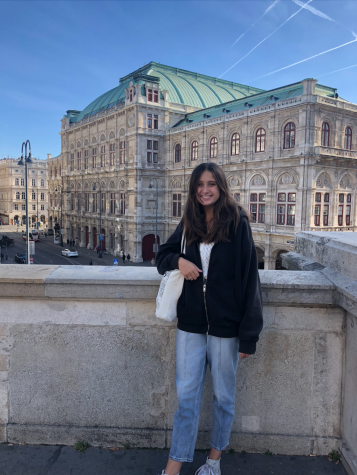
I am in the class of 2023 and I write about many different topics. I enjoy baking and reading in my free time and my favorite classes are Global Politics...



